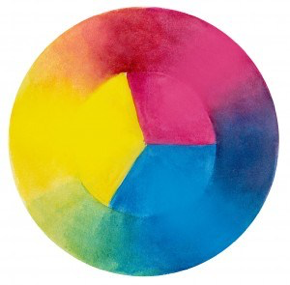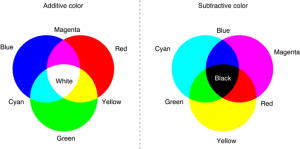
Cyan is a color overlooked all too often probably because it isn’t a common color that we see day to day. While it is confused as a “bright turquoise,” cyan is more present than you imagine. Recall learning, in elementary school (or lower school if that suits you better), about the primary colors… red, yellow, and blue, right? Yeah, but there’s a grown-up’s lesson too.
Red, yellow, and blue are primary colors, but only for light. Primary colors also operate in the world of pigmentation, however, where light appeals to the biological side of colors, pigmentation pertains to the physics of color. The primary colors of pigmentation are cyan, magenta, and yellow.
CMYK
If you’ve ever been shopping for printer toner you’ve probably come across these four letters. These letters stand for the colors that will print all your pictures and color documents. Cyan, magenta, yellow, and black are the colors that make up every other color in color printing.

CMYK
If you’ve ever been shopping for printer toner you’ve probably come across these four letters. These letters stand for the colors that will print all your pictures and color documents. Cyan, magenta, yellow, and black are the colors that make up every other color in color printing.
The additive color theory, under which the primary colors or RGB color model operates, is a method that creates color by mixing a number of different light colors with varying levels of RGB. This is how our TV screens work; they use the RGB (red, green, blue). The cones in our eyes are receptive to red, green, and blue light, so the combination of these can be used to “trick” ourselves into seeing a full spectrum of colors through numerous combinations of red, green, and blue bulbs in our screens.

The secondary colors, or CMYK color model, is explained by the subtractive color theory, through which color is created by absorbing parts of the spectrum of light. Pigmentation operates under the subtractive color theory—a pigment absorbs a certain amount of the white light that is shown, and reflects the colors we see and perceive in our minds. White light consists of red, green, and blue light. Cyan pigment absorbs red but reflects blue and green. To print in color, computers are programmed to figure out the correct proportions of cyan, magenta, yellow, and black to produce a cohesive image.

CMYK printing did not become more ubiquitous until the 1950s, when Pantone Inc. searched for a way to streamline their printing process. In fact, it wasn’t until the 1980s when RGB display was formally introduced to consumers. The concept is similar, but again, play on different aspects based on how each is perceived.
4 Color Paint
Painter Charlie Hankin replicates this very process as an inspiration for his style of painting. His colors are smooth and vibrant. The hues are precise and static. This is because he paints using only four colors—cyan, magenta, yellow, and black. From four stripes of the CMYK color scheme, he carefully mixes to attain the right color.
This is amazing to any painter that’s ever had an attempt to mix colors turn into a marshy brown. Nonetheless, Hankin does not have the precision to mix a full spectrum of colors. He is limited within the colors he can produce. Working within this cold aesthetic, his work is a comment on the impact of our computers as well as how computers make us see images.

https://charliehankin.com/category/paintings/page/2/
The familiarity of this image is strange, but it is a quintessential depiction of an age we’ve all grown up knowing. Video communication has become something of the past recently, but we all know the blue tint of the screen; the ambient, cyan glow mimics the reflection of a laptop screen as seen in a Skype call.
Cyan Stains
My most exhilarating experience seeing cyan also happens to be the reason for this article. It happened this winter break, when I was in Costa Rica with my family. After driving for four hours on the bay, we arrived at the pier. It was a warm Costa Rican night when we packed into our kayaks. As dusk arrived, we set out in our kayaks across the bay. The water had a blue tint to it when we paddled. I was disappointed because I knew what I came to see and this wasn’t it.
After about 15 minutes of paddling through the warm breeze, we slowed and beached. It was finally dark, with the exception of a full moon. One of us took a paddle a skimmed the surface of the water in an arc. The water lit up like cyan paint was being splashed in it. We had come on this tour to see the bioluminescent plankton.

The next half hour was full of childish bliss. Running through the water, the glow of the bioluminescence splattered onto the water like paint, and then disappeared. Zooplankton and algae are responsible for the bioluminescence, and only light up when disturbed. This is the stuff that feeds whales, like the scene in The Life of Pi when the whale pops out of the glowing sea. I wish I could’ve taken the above picture, but my lens and camera weren’t strong enough.
Finding a part of the water with a higher concentration of the plankton was amazing, as the glow of cyan was unreal. I kid you not, it was as bright and vibrant as the swatch on this article’s cover. As we looked on the beach, the bioluminescence would ride the crest of the waves and light it up, like a real life animated neon sign. Everyone acted like a 5-year-old, splashing around on the beach, trying to hold the bioluminescence in their hands.
It wasn’t nearly as dramatic nor as consistent as it was in The Life of Pi. But that made it all the better. It was dark, and seeing the sharp flash of the bioluminescence was exciting, even if only for a second.

So, keep an eye out for the color cyan. As you realize and understand more colors, everyday objects start to look a little different. Knowing the color that makes up every part of an object is really mind blowing, considering the fact that there is an endless amount of colors.
JORDAN CHAN | Amateur Nature Photographer | KXSU Arts Reporter

